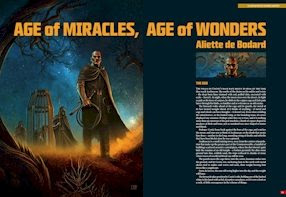 This week's story recommendation is for "Age of Miracles, Age of Wonders" by Aliette de Bodard, from the September-October 2010 issue of Interzone. Aliette de Bodard is the first three-time SROTW recipient, which will surprise no one who has read her work. Lately I've been trying to teach myself to write decent short fiction, and so I have a mental list of very good authors to read and learn from. Well, de Bodard has moved off that list, onto the list of writers I don't dare try to emulate or I might hurt myself.
This week's story recommendation is for "Age of Miracles, Age of Wonders" by Aliette de Bodard, from the September-October 2010 issue of Interzone. Aliette de Bodard is the first three-time SROTW recipient, which will surprise no one who has read her work. Lately I've been trying to teach myself to write decent short fiction, and so I have a mental list of very good authors to read and learn from. Well, de Bodard has moved off that list, onto the list of writers I don't dare try to emulate or I might hurt myself."Age of Miracles, Age of Wonders" shows us a fascinating, original setting, where the Aztec Empire has been replaced by a strange, machine-dominated culture that never (quite) existed in our world. (Note that this is not the setting of de Bodard's debut novel Servant of the Underworld, although it could be in the same universe at a later date.) Even better, the story doesn't just use that setting for scenery, but to frame important questions de Bodard would not have been able to convey through a mimetic setting or a conventional medieval fantasy background.
In "Age of Miracles, Age of Wonders," the new god-machine has done away with the sacrifices and brutality of the former empire and its bloodthirsty deities. A mechanical "heirarch" arrives in a small mining town with the last of the old gods in chains, to conduct a symbolic execution of the god, who will only be resurrected for the next stop on their tour. But the ordinary people of this town are beginning to question whether they are any better off under the machine-god, which demands their hard labor in the mines to sustain it. We see the points of view of the old god, the heirarch, and the townspeople, all of whom are conflicted in different ways, but de Bodard offers no simple answers to their conflicts.
"Age of Miracles, Age of Wonders" is set after the time of the Aztecs' human sacrifices, but it prompts us to wonder what sacrifices we are still making, for which we will never be able to atone.

No comments:
Post a Comment